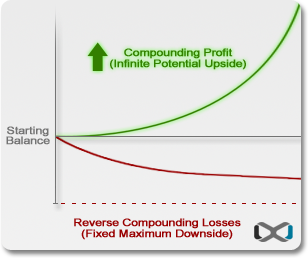The Golden Rule in Forex Risk Management
In speculative forex trading, it is wise to limit your risk on each trade to 1% of your total account size.
Many new traders think this is preposterous. “1% of my account is only $10, how can I possibly make any money”, they say.
While such a low exposure to risk might lack the excitement of (potentially) turning your small kitty into a great fortune… sooner or later, you will realize the necessity of such a conservative approach.
Treat your account like a submarine
By capping the risk on each trade to 1% of your account, you increase the probability of your survival during choppy or unfavorable market conditions. Even if you lose 10 trades in a row, you’ll still have (more than) 90% of your initial balance. Small drawdowns like this can be made back with 2-3 great trades – and new account highs may be achieved once again.

Consider a submarine that has had its internal rooms hollowed out to form one giant hollow floating tube. If the sub was attacked by a missile from an enemy ship, a single blow would cause it to fill up and sink immediately. Now take that same submarine and have it retrofitted with strong dividers so that it now contains 100 watertight compartments, all equal in size.
If the sub was attacked again by an enemy ship, just one of the compartments would fill up, leaving the other 99 intact to keep the vessel afloat. The submarine could take hit after hit before sinking, giving it enough time to escape enemy fire and return to safety.
Think of your trading account like this submarine.
By capping your risk to 1% on each trade, you are essentially dividing your account into 100 equal partitions, and accepting a maximum loss of just one compartment at a time. This survival technique is critical in keeping your account alive long enough to enjoy the calm blue waters of profitable trending conditions.
Not only does a 1% risk model preserve your capital, but during a series of losses, the risk on each trade becomes progressively smaller and smaller, forming a reverse compounding effect. In the previous psychology lesson, we showed you how consistent profits become progressively larger as a result of compounding…
The inverse is also true.
During periods of losing trades, your losses will progressively get smaller. The simple act of risking a fixed percentage per trade ensures that your account harnesses the power of compounding on the way up, whilst also taking advantage of the reverse compounding effect during periods of drawdown.

During periods of account drawdown, a 1% risk model forces your risk to become progressively smaller and smaller. Sounds logical, right? Yet most traders do exactly the opposite of this.
Systems such as the “Martingale” encourage traders to double their stake after each loss. Gamblers love systems like the Martingale, as it allows them to buy into the false belief that they’ll get away with never fully realizing a loss. In a hypothetical environment of infinite capital and infinite market liquidity, the theory may hold water… but in the real world, it’s pure fantasy, and a sure way to blow your entire account.
Do the maths
Many new traders open an account and deposit $1,000 or $2,000 then proceed to risk $100-$200 per trade.
$100 or $200 risk per trade isn’t that much, right? Wrong. This represents up to 10% of their account!
If you think risking 10% of your account per trade is sustainable, we urge you to complete the experiment below.
https://www.youtube.com/watch?v=TwhM_O7Jmng
Scalping: A mug’s game
In Lesson 5 of the Infinite Prosperity course, we delve into the world of financial brokers. In one unit, we warn against the inherent risks of adopting a scalping-type strategy.
Here’s a segment from that lesson:
A rookie who attempts to scalp the 1 minute chart in pursuit of micro-profits (such as 4-5 pips) will require a large trade size, sometimes $30-40 per pip. On a 3 pip spread, this is a guaranteed $120-200 profit for the broker, per trade (not including commissions).
Undercooked cash-grab scalping strategies such as these can be exhilarating in the short term. Dopamine and adrenaline flood the system, and a win can send a traders pride through the stratosphere. This pulls him away from objective reasoning and brings online the animalistic pleasure centers in the brain. This is now gambling, not trading.
Hunting for 4-5 pips at a time means each trade can be over in a matter of minutes. Therefore, the scalper often performs 5, 10 or 20+ trades in any given session.
Reward:
If a scalper targets a 7 pip market movement, he will realize 4 pips of profit after paying a 3 pip spread.
Risk:
If he is actually using a stop loss order (many do not), he may have it set it to trigger after a 7 pip market movement to the downside. In this situation, he would lose a total of 10 pips (7 pip movement + 3 pip spread).
Possible Outcomes:
- Market moves up 7 pips: Scalper realizes a 4 pip profit.
- Market moves down 7 pips: Scalper realizes a 10 pip loss.
Maths:
After costs, he is essentially risking 10 pips to make just 4. This scalper must trade with a 72% strike rate just to break even. To actually make a net profit, his strike rate will have to approach 80%. This means he must win 4 in every 5 trades. On 1 a minute chart, filled with market noise and inexplicable price spikes?! I’m yet to personally see any trader achieve this feat successfully over any significant period of time…
In the meantime, the broker is cashing in on this erratic and emotional trading behavior. At the front end, they could be making $120-$200 per trade. At the back end, they’ve likely flagged this trader for the B-Book. Within 90 days, statistically speaking this trader will have donated 90% of his initial account balance to the broker (on top of front-end trading costs).
Scalpers are the forex brokers dream client.
After the scalper blows an account, you can bet your last dollar the broker will deploy their leading salesman to make the phone call. They may have scripts, tactics, explanations, sympathies, bonus offers and other tools at their disposal. The goal? To get the scalper to deposit another chunk of cash, so he can do it all over again.
This is not the path to mastery. Avoid scalping as if your financial future depends on it.



Leave a Comment